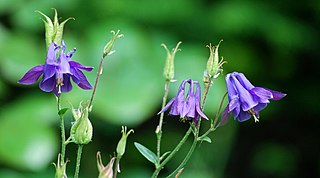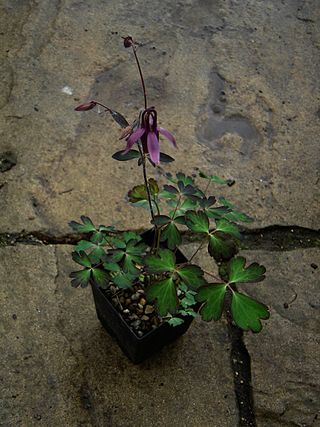
Aquilegia is a genus of about 130 species of perennial plants that are found in meadows, woodlands, and at higher elevations throughout the Northern Hemisphere, known for the spurred petals of their flowers.

Heinrich Moritz Willkomm was a German botanist who served as a professor of botany at Tharandt, the University of Dorpat and at the University of Prague. He travelled widely across Spain and Portugal and became a specialist on the flora of the Iberian region. The standard author abbreviation Willk. is used to indicate this person as the author when citing a botanical name.

Nepeta nepetella, common name lesser cat-mint, is a low-growing species of catnip belonging to the family Lamiaceae. It is native to France, Spain, Italy, Algeria, and Morocco.
- Nepeta nepetella subsp. aragonensis(Lam.) Nyman - Spain, Algeria, Morocco
- Nepeta nepetella subsp. laciniata(Willk.) Aedo - Sierra Nevada of southern Spain
- Nepeta nepetella subsp. murcica(Guirão ex Willk.) Aedo - Morocco, southern Spain
- Nepeta nepetella subsp. nepetella - Pyrenees, western Alps, + Apennines of Spain, France, Italy
Iris serotina is a species in the genus Iris, it is also in the subgenus Xiphium. It is a bulbous perennial from southern Europe, found in Spain and Morocco.

Microcnemum is a genus in the plant family Amaranthaceae, containing a single species, Microcnemum coralloides. It is a dwarf annual halophyte with fleshy, apparently jointed stems and reduced leaves and flowers. The two subspecies show a disjunct distribution in Spain and Western Asia.

Aquilegia rockii is a perennial flowering plant in the family Ranunculaceae, native to southern China.
Aquilegia incurvata, or the Qinling columbine (秦岭耧斗菜), is a perennial species of flowering plant in the family Ranunculaceae, endemic to the Qinling mountain range in China.

Aquilegia kitaibelii is a perennial species of plant in the family Ranunculaceae, native to Croatia, Bosnia and Herzegovina, and possibly Slovenia.
Aquilegia apuana is a perennial flowering plant in the family Ranunculaceae, endemic to central Italy.
Aquilegia atwoodii, commonly known as Atwood's columbine, is a perennial flowering plant in the family Ranunculaceae, endemic to Utah.
Aquilegia ballii is a perennial flowering plant in the family Ranunculaceae, endemic to Morocco.
Aquilegia baluchistanica, common name the Balochistan columbine, is a perennial flowering plant in the family Ranunculaceae, endemic to Pakistan. It has pink flowers.

Aquilegia barykinae is a perennial flowering plant in the family Ranunculaceae, endemic to the Russian Far East. The species was first described in 2014. Its flowers are lilac-blue.

Aquilegia bashahrica is a perennial flowering plant in the family Ranunculaceae, endemic to the Himalayas.

Aquilegia cazorlensis is a perennial flowering plant in the family Ranunculaceae, endemic to southeastern Spain.
Aquilegia chitralensis is a perennial flowering plant in the family Ranunculaceae, endemic to Pakistan.
Aquilegia colchica is a perennial flowering plant in the family Ranunculaceae, endemic to the Caucasus mountains in Georgia. The plant blooms in spring with blue and white flowers. It is considered an endangered species in Georgia.
Aquilegia cymosa is a perennial flowering plant in the family Ranunculaceae, endemic to Pakistan.
Aquilegia dichroa is a perennial flowering plant in the family Ranunculaceae, native to Portugal and northwestern Spain.

Aquilegia discolor, commonly known as the two-coloured columbine, is a perennial flowering plant in the family Ranunculaceae, endemic to northwestern Spain.









